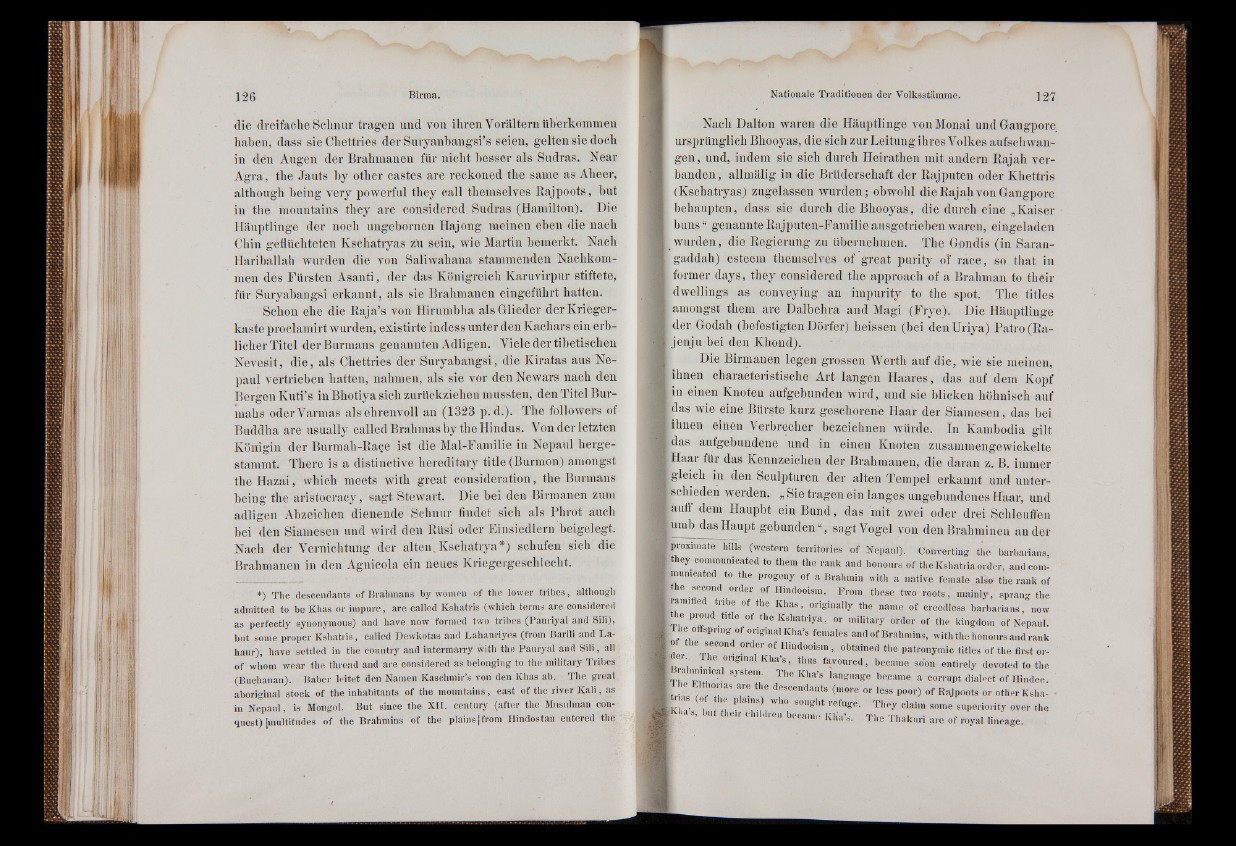
die dreifache Schnur tragen und von ihren Yorältern überkommen
haben, dass sie Chettries der Suryanbangsi’s seien, gelten sie doch
in den Augen der Brahmanen für nicht besser als Sudras. Near
Agra, the Jauts by other castes are reckoned the same as Aheer,
although being very powerful they call themselves Rajpoots, but
in the mountains they are considered. Sudras (Hamilton). Die
Häuptlinge der noch ungebornen Hajong meinen eben die nach
Chin gefluchteten Kschatryas zu sein, wie Martin bemerkt. Nach
Hariballah wurden die von Saliwahana stammenden Nachkommen
dès Fürsten Asanti, der das Königreich Karuvirpur stiftete,
für Suryabangsi erkannt, als sie Brahmanen eingeführt hatten.
Schon ehe die Raja’s von Hirumbha als Glieder der Kriegerkaste
proclamirt wurden, existirte indess unter den Kachars. ein erblicher
Titel derBurmans genannten Adligen. Viele der tibetischen
Nevesit, die, als Chettries der Suryabangsi, die Kiratas aus Ne-
paul vertrieben hatten, nahmen, als sie vor den Newars nach den
Bergen Kuti’s in Bhotiya sich zurückziehen mussten, den Titel Bur-
mahs oderVarmas als ehrenvoll an (1323 p. d.). The followers of
Buddha are usually called Brahmas by the Hindus. Von der letzten
Königin der Burmali-Raçe ist die Mal-Familie in Nepaul hergestammt.
There is a distinctive hereditary title (Burmon) amongst
the Hazai, which meets with great consideration, the Burmans
being the aristocracy, sagt Stewart. Die bei den Birmanen zum
adligen Abzeichen dienende Schnur findet sich als Phrot auch
bei den Siamesen und wird den Rüsi oder Einsiedlern beigelegt.
Nach der Vernichtung der alten. Kschatrya*) schufen sich die
Brahmanen in den Agnicola ein neues Kriegergeschlecht.
*) The descendants of Brahmans by women of the lower trib e s , although
admitted to be Khas or impure, are called Kshatris (which terms are considered
as perfectly synonymous) and have now formed two tribes (Pauriyal and Sili),
but some proper K sh atris, called Dewkotas and Lahauriyes (from Barili and La-
haur), have settled in the country and intermarry with the Pauryal and S ili, all
of whom wear the thread and are considered as belonging to the military Tribes
(Buchanan). Baber leitet den Namen Kaschmir’s von den Klias ab. The great
aboriginal stock of th e inhabitants of the mountains, east of the river K a li, as
in Nepaul, is Mongol. But since the XII. century (after the Musulman conquest)
¡multitudes of the Brahmins of the plains|from Hindostan entered the
Nach Dalton waren die Häuptlinge von Monai und Gangpore
ursprünglich Bhooyas, die sich zur Leitung ihres Volkes aufschwangen,
und, indem sie sich durch Heirathen mit ändern Rajah verbanden,
allmälig in die Brüderschaft der Rajputen oder Khettris
(Kschatryas) zugelassen wurden; obwohl die Rajah von Gangpore
behaupten, dass sie durch die Bhooyas, die durch eine „Kaiser
1 buns“ genannte Rajputen-Familie ausgetrieben waren, eingeladen
■ wurden, die Regierung zu übernehmen. The Gondis (in Saran-
■ gaddah) esteem themselves of great purity of race, so that in
■ former days, they considered the approach of a Brahman to their 11 dwellings as conveying an impurity to the spot. The titles
I amongst them are Dalbehra and Magi (Frye). Die Häuptlinge
J der Godah (befestigten Dörfer) heissen (bei denUriya) Patro(Ra-
B je n ju bei den Khondj.
Die Birmanen legen grossen Werth auf die, wie sie meinen,
I ihnen characteristische Art langen Haares, das auf dem Kopf
■ in einen Knoten aufgebunden wird, und sie blicken höhnisch auf
■ d as wie eine Bürste kurz geschorene Haar der Siamesen, das bei
■ ihnen einen Verbrecher bezeichnen würde. In Kambodia gilt
■ d a s aufgebundene und in einen Knoten zusammengewickelte
■Haar für das Kennzeichen der Brahmanen, die daran z. B. immer
I gleich in den Sculpturen der alten Tempel erkannt und unters
c h ie d e n werden. „ Sie tragen ein langes ungebundenes Haar, und
■auff dem Haupbt ein Bund, das mit zwei oder drei Schleuffen
■ umb das Haupt gebunden“, sagt Vogel von denBrahminen ander
■ p ro x im a te hills (western territories of Nepanl). Converting the barbarians,
■ th ey communicated to them the rank and honours of the K shatriaorder, andcom-
■ mumcated to the progeny of a Brahmin with a native female also the rank of
■ the second order of Hindooism. Prom these two roots, mainly, sprang the
■ ramified tribe of the Khas, originally the name of creedless barb arian s, now
■ he proud title of the Kshatriya, or military order of the kingdom of Nepaul.
■ ie offspring of original Kha?s females and of Brahmins, with the honours and rank
B , . °rder 0f I!ind00isra - obtained the patronymic titles of the first or- Bt.fi • ,e 0ugl"al Khas> thns favoured, became soon entirely devoted to the
B l 'h Sys em' 1 h(! Kha’s language became a corrupt dialect of Hindee.
B M T H h I I deSCendantS (m0,'e or ]ess P°or) of Rajpoots or other Ksha- ■
A§ 1,-1, .. , ’O 1 ai'lß wl‘° H f l f f i refuge. They claim some superiority over the
M t ' * ’ tlKi"' ChlU,ren " i l l The Thakuri are of royal lineage.